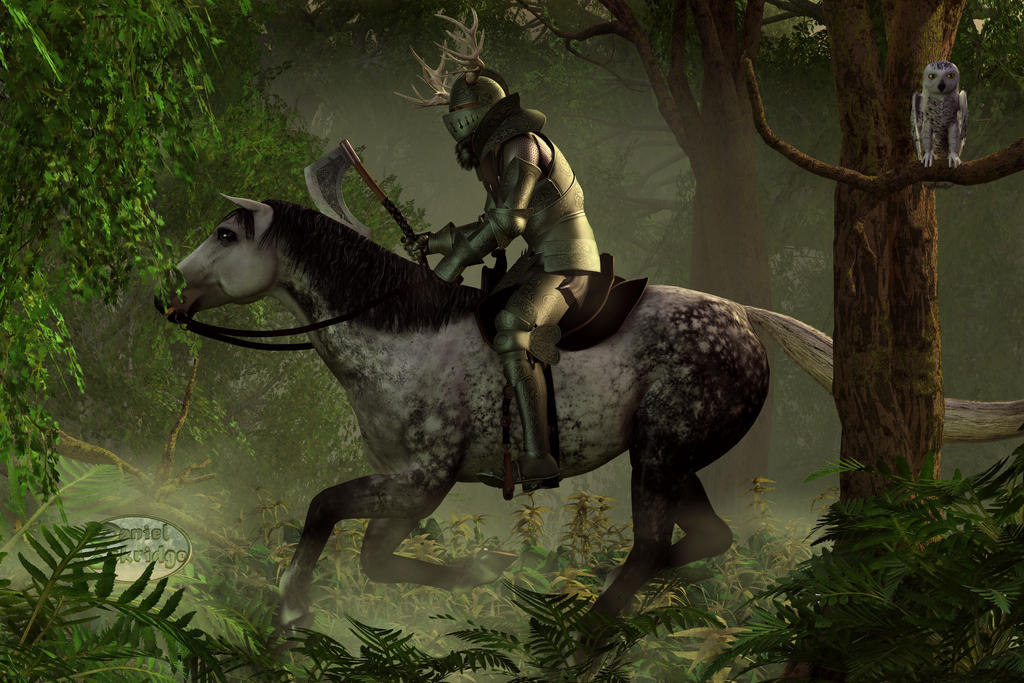ShopDreamUp AI ArtDreamUp
Deviation Actions

Tip Jar
Support my work by contributing to my tip jar. This tier won't include any specific perks, but you will receive my appreciation.
$1/month
Suggested Deviants
Suggested Collections
You Might Like…
Featured in Groups
Description
The Green Knight is a character from Arthurian Legend. He appears in several stories, and like many of the King Arthur stories, he is somewhat inconsistently portrayed. For instance, in “Gawain and the Green Knight”, he is a villain, yet in "King Arthur and King Cornwall" he is a hero. He goes by the name Bercilak, Berkilak, or Bredbeddle and is described as wearing all green. Sometimes, he even has green skin. There are quite a few interpretations as to why he is green, but generally he is thought to be a version of the Green Man common in medieval art. I gave his armor a more olive tint as a more pure green made it look too much like plastic.
This image was built using content purchased from Daz3d.com. The knight and horse were posed using Poser. The rest of the scene was constructed in Vue. Rendering was done in Vue. It took about a week (all that fog). Post production was done using GIMP.
This image was built using content purchased from Daz3d.com. The knight and horse were posed using Poser. The rest of the scene was constructed in Vue. Rendering was done in Vue. It took about a week (all that fog). Post production was done using GIMP.
Image size
5400x3600px 13.11 MB
© 2011 - 2024 deskridge
Comments61
Join the community to add your comment. Already a deviant? Log In
Sir Gawain and the Green Knight was part of the "Alliterative Revival," which returned to verse more akin to that used in Old English (e.g., Beowulf) than the verse of the day that we'd read in contemporary texts, like Chaucer. At this point in time, most of the Arthurian material had left "Britain," gone over the channel, and travelled through Europe, where many of the characters and stories we know and think of today as being Arthurian were invented, wholesale, by French and German (and many other) poets. From there, they'd travel back to England and create the contradictions we now see when we look at the extant body of Arthurian work.
That said, Sir Gawain and the Green Knight was not of the same Middle English dialect as Chaucer's (or most of England's). It was rustic and deliberately, both with its alliterative form and its language, called the reader back to the days before the Norman Conquest. It, and other poems like it (i.e., The Alliterative Morte Arthure, which is perhaps the single best Arthurian poem ever written), were put together as a deliberate cultural attempt to displace Norman and French literature (and culture) with what was seen as authentic English literature (which, ironically, was authentic British literature about the Britons' attempts to ward off the Germans who would become the English).
To read the Alliterative Morte Arthure is to read the final chapter of Geoffrey of Monmouth's History written as an epic poem. What is notable about it is that it does not contain continental contaminants: it contains a story that we assume to be very close to the ur-Arthur tragedy and does not, as would Malory's version, attempt to reconcile the contradictions that had cropped up in the legends over the centuries (it's worthwhile to note that, in the Alliterative Morte Arthure, Gawain is Arthur's first knight. Lancelot — a French interpolation —is not a character. Both it and Sir Gawain and the Green Knight are theorized to present their respective stories as they would have been told before the exportation of the Matter of Britain and its subsequent importation.
In other words, while there are, as you note, many contradictions when it comes to the Green Knight and his depictions, it is highly likely that the Green Knight as he appears in Sir Gawain and the Green Knight is the most authentic literary record we have of the role that he originally played in the original British legends and myth.
You've given us a great image of him, btw.

That said, Sir Gawain and the Green Knight was not of the same Middle English dialect as Chaucer's (or most of England's). It was rustic and deliberately, both with its alliterative form and its language, called the reader back to the days before the Norman Conquest. It, and other poems like it (i.e., The Alliterative Morte Arthure, which is perhaps the single best Arthurian poem ever written), were put together as a deliberate cultural attempt to displace Norman and French literature (and culture) with what was seen as authentic English literature (which, ironically, was authentic British literature about the Britons' attempts to ward off the Germans who would become the English).
To read the Alliterative Morte Arthure is to read the final chapter of Geoffrey of Monmouth's History written as an epic poem. What is notable about it is that it does not contain continental contaminants: it contains a story that we assume to be very close to the ur-Arthur tragedy and does not, as would Malory's version, attempt to reconcile the contradictions that had cropped up in the legends over the centuries (it's worthwhile to note that, in the Alliterative Morte Arthure, Gawain is Arthur's first knight. Lancelot — a French interpolation —is not a character. Both it and Sir Gawain and the Green Knight are theorized to present their respective stories as they would have been told before the exportation of the Matter of Britain and its subsequent importation.
In other words, while there are, as you note, many contradictions when it comes to the Green Knight and his depictions, it is highly likely that the Green Knight as he appears in Sir Gawain and the Green Knight is the most authentic literary record we have of the role that he originally played in the original British legends and myth.
You've given us a great image of him, btw.



































